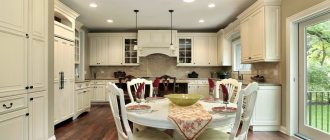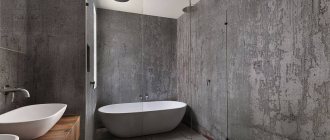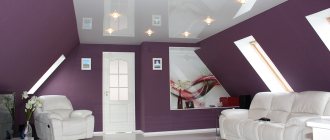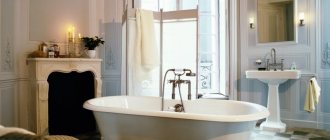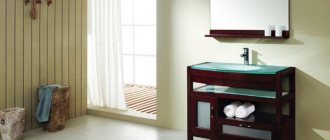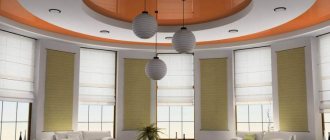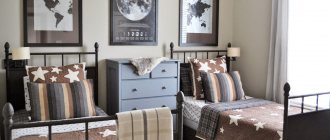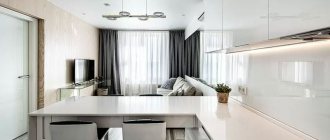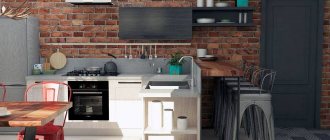Despite its small size compared to other rooms in a city apartment, lighting in a bathroom with a suspended ceiling needs to be planned more responsibly. In this article we will tell you in detail about the types of lighting for the bathroom, the most advantageous places for its placement and much more.
Lighting in a bathroom with a suspended ceiling.
Features of organizing lighting in a suspended ceiling in a bathroom
When organizing ceiling lighting in a bathroom with PVC film, several conditions must be met:
- choose light sources that are not too bright;
- the rays of the lamps should be moderately scattered;
- light sources should be chosen in accordance with the interior;
- Lamps should be placed rationally;
- they must be resistant to high humidity;
- Based on intensity, light is divided into two groups;
- use only durable and economical lighting options.
Remember, lighting in the bathroom, where there will be suspended ceilings, is planned in advance. You will not be able to make adjustments after installing the PVC film.
Placing a ceiling lamp in a suspended ceiling of a bathroom Source beloe-oblako.ru
The idea of lighting a ceiling chandelier in a spacious bathroom with additional spotlight Source format-potolok.ru
The placement of spotlights is symmetrical in the PVC ceiling of the bathroom Source vilok.ru
Selecting the appropriate lighting power
Of course, there are engineering laws, formulas for calculating illumination with several variables and exact results. But in practice, the lighting intensity is rather selected by eye, based on the principles of “like-dislike”, “already annoying or still quite tolerable”.
The number of mirror and reflective (glossy) surfaces plays an important role: they visually increase illumination.
If there are many light sources, you can consult with a designer, a technical specialist, or simply on an Internet forum.
It is important to take into account sources of natural light: windows in bathrooms are not uncommon in dachas and cottages, and in city apartments there are transparent windows under the ceiling. During the daytime, they allow you to save electricity - use the bathroom without turning on the lights.
Lighting options in a bathroom with a suspended ceiling
Most bathrooms in apartments and houses do not have windows. Therefore, all efficiency falls on artificial lighting. The location can be of several options:
- wall;
- ceiling;
- floor;
- built-in (this refers to interior items: wall shelves, bedside tables and other furniture).
The wall and ceiling arrangement of lamps is suitable for a bathroom of any style and size. Floor lighting, LED lighting in the form of decor will dilute the atmosphere and create a spectacular play of shadows. In modern interior solutions, it is possible to combine all methods of placing lamps in the bathroom at the same time. Lighting in the bathroom must be grouped. Each specific group is used separately. Individual switches are provided for them.
Decorative lighting for a mirror in a bathroom with a suspended ceiling Source womanadvice.ru
On a note! For convenient adjustment of light fluxes from lamps, roller switches are installed. They are well protected from moisture.
What not to do
There are prohibitions for the entire premises and for its individual zones.
Restrictions according to GOSTs and SNiPs
Prohibited activities are listed in local regulations. These lists may differ in different regions, but basically they are the same. For Moscow, Resolution No. 508 PP applies. According to this document, it is prohibited to lay grooves in reinforced concrete slabs and interpanel joints.
Channels can be laid in the finishing or under a suspended ceiling or plasterboard sheathing of a metal frame.
Some restrictions are introduced by GOSTs and SNiPs. Technical standards prohibit open wiring. You can only use a triple wire with a phase, neutral and protective conductor. Each of them must be in its own protective shell. All three wires are connected together under an additional layer of insulation.
The use of metal coating without insulation is not permitted.
For laying, corrugated or plastic pipes should be used. Metal ones cannot be used. If the cable is damaged, such a coating will not be able to protect against electric shock. The use of electrical tape is not permitted.
There is no need to skimp on communications. It is better to take a thicker section so that the core does not burn out under intense loads. Typically, an aluminum cable with a cross-section of 4 mm2 or a copper cable with a cross-section of 2.5 mm2 is used. You cannot combine copper and aluminum - this will lead to a reaction between them.
It is prohibited to place switches, electrical panels and distribution boxes in the bathroom.
Sockets and all devices must have a residual current device (RCD). There are special models for wet rooms. All equipment must be grounded. To minimize the risk, even a bathtub can be grounded if it is made of steel or cast iron.
Under no circumstances should you do grounding yourself by connecting a wire to a heating radiator or water pipe. This can be dangerous to life and health.
According to the Civil Code of the Russian Federation, any changes that require inclusion in the technical passport and the BTI plan require the creation of design documentation.
Only an engineering organization with SRO approval can draw up a project. Documentation must be approved by government authorities. The installation of lighting, as a rule, cannot be classified as a refurbishment, but it may be part of a plan that requires a number of changes to be made to the layout and energy supply of the apartment.
To avoid mistakes, everything must be carefully planned and calculated before starting work. To avoid getting an electric shock, you should work with the electricity turned off.
Restrictions for individual zones
Lighting in a small bathroom, as well as in a spacious room, depends on areas with different degrees of humidity.
Four sections can be distinguished:
- The space above the bathtub, as well as inside the shower stall, where there is especially a lot of water and steam, and the humidity concentration is the highest. Here you can install lamps with a power of up to 12 W with a protection index of IP 674 or more. This parameter is always indicated on the packaging or in the instructions. The first number indicates the degree of protection against dirt. It ranges from 1 to 6. The second shows how well the product is protected from water and steam. The maximum value is 8. At this level, it can be immersed in liquid for a long time. The last number is impact resistance. It ranges from 0 to 10.
- The space adjacent to the sink and shower stall and other plumbing fixtures. Drops of water may reach here. You can use lamps with a power of up to 24 W and a degree of protection IP 452.
- An area located at a distance of 50 cm from the sink and other appliances. There are no power restrictions here anymore. The index must be at least IP 242.
- The last section is everything that comes next. Drops usually don't reach here. Moisture enters here in the form of steam and condensate. Devices with an IP rating of 011 and higher are used in this area.
This zoning applies regardless of the presence of a hood. It is suitable for separate and combined bathrooms.
overhead light
Ceiling lighting is further classified into several types: central, spot, contour.
PVC film in the bathroom ceiling with perimeter lighting Source yandex.ru
- Central. It involves installing only one lamp in the center of the room. Usually it is wide, but not very prominent under the ceiling.
- Spot. Involves the installation of several spotlights in a suspended ceiling. For this, rotary or conventional waterproof options are used.
- Contour. When organizing this option, the light is located around the perimeter of the room. For this, LED strip or separately installed lamps are used.
When organizing ceiling lighting, lamps of overhead or built-in mounting methods are used. The size of the lamp and the number of sources are chosen based on the area of the room. You can complement a spacious room with high ceilings with a large beautiful chandelier. Glass or crystal shades are installed at a distance from the PVC ceiling film. Compact bathrooms should not have large ceiling chandeliers. They take up free space and do not allow you to visualize the design style of PVC film.
Lighting with square lamps in a suspended ceiling of a bathroom Source remontnik.ru
Stretch ceiling with chaotic placement of spotlights in the bathroom Source masterpotolok.com
Spot lighting is no less popular. This is suitable for any size room. To organize correctly directed light, several points with light bulbs are used. They are carefully mounted into a suspended ceiling. Using different methods of placing spotlights in a PVC ceiling, you can create a calm, defiant, peaceful atmosphere.
Contour lighting (around the perimeter) is suitable for small and large bathrooms. Lighting is organized using LED strip or miniature lamps. Light can be flashing, scattering, concentrated. For modern interior solutions, the installation of multi-colored RGB strips is welcome.
Light in the bathroom with spotlights in the suspended ceiling along its perimeter Source omskprestige.ru
Ceiling lighting is equally suitable for matte and glossy ceiling textures. The only caveat is that light behaves differently with each surface option. Glossy is reflected, matte is absorbed.
Imitation of daylighting in a suspended ceiling of a bathroom Source potolkikaluga.ru
What type of lamp should I choose?
Today, the choice of lighting devices is so extensive that everyone can choose the option that best suits their wishes. So, according to the type of location on the surface, lamps can be:
- open;
- built- in This option is preferable for miniature bathrooms with not very high ceilings.
Depending on the location, the lamps can be:
- ceiling _ This is a timeless classic. Each bathroom should be equipped with at least one ceiling lamp, which will be responsible for the general light in the room;
- wall- mounted These are lamps that are designed to highlight certain functional areas of the room;
- floor lamps perform more of a decorative function; they can add zest to the interior of a room and visually expand the space of the room.
Each of the lamps used can perform one or several of the following functions:
- work lighting;
- decorative lighting;
- directional lighting;
- general lighting.
, different types of lamps can be used as light sources
- incandescent lamps;
- halogen;
- luminescent;
- LED
Everyone has the right to choose the type of lamps themselves, depending on the type of lamp or their own desire to save money, but special attention should be paid to LED lamps. They are considered the most economical and safe, because they do not heat up during operation. LED strip is also often used, which adds a real zest to the bathroom interior.
The only drawback of LED lamps is their high price.
Wall light
Lighting that extends from the wall allows you to make your bathroom design unique and rich. When installing lamps above the height of a person, they will be perfectly reflected in the glossy surface of the stretch ceiling. This creates a visualization of expanded space.
Illumination of functional areas in the bathroom Source roomester.ru
Lamps can be overhead or built into the walls. The latter are relevant if the room has interior niches and shelving. Wall lamps are also considered convenient for illuminating functional areas in a room: near the mirror, above the washbasin, next to the toilet set.
Wall lamps for a spacious bathroom with a suspended ceiling Source tskmn.ru
Criteria for choosing lamps for the bathroom
Lighting stores offer such a variety of lamps with a wide variety of characteristics that it is easy to get confused and make a mistake when choosing. Below are the most important criteria that bathroom lighting must meet.
Lighting fixtures in the bathroom must be highly moisture resistant.
The main requirements for bathroom fixtures:
- Environmental friendliness. The main thing is to make sure that no substances harmful to health and the environment are used in the manufacture of lamps.
- Energy saving. Not only are halogen lamps not the safest for our health, they also consume more energy than LED lamps.
- Durability. Modern manufacturers make lamps from durable materials. Often on store shelves you can find a device made of glass or metal. Also, the crystals in LED lamps burn out much less often than others.
- Minimum radiation dose. The lamp should not heat up the furniture and suspended ceiling even when left with them for a long time, and your eyes should not begin to hurt, dry out or, conversely, water.
- A variety of color backlight choices and the ability to adjust color temperature and light brightness. This feature comes at a higher price point, but it's definitely worth it. But even LED lighting, like everything in the world, has its drawbacks that cannot be ignored.
- Price. Of course, this is one of the most important factors when choosing lighting. But if you look at this drawback from the other side, it becomes clear that the price of the lamp quickly pays off. A one-time investment in LED lighting cannot be compared with the monthly replacement of cheaper analog lamps.
- Resistance to moisture and temperature changes. Obviously, the bathroom is a high-humidity area, which can have a negative effect on some lamps, so be sure to consider the level of water resistance when purchasing lighting elements.
Bathroom design with black stretch ceiling.
Floor and decorative lighting
Decorative lighting options will provide spiritual harmony. They can be located in steps, ramps, rises, which are built in the bathroom and have a functional role. Often the bathing container itself has built-in floor lighting, protected from water.
Lighting the baseboard of furniture in the bathroom Source dekormyhome.ru
Lighting in the bathroom, which is reflected in the suspended ceiling Source dekor.expert
Interesting bathroom with lighting around the bathtub Source svet-x.by
With the help of lighting, the contours of the shower stall, mirror, bathtub, and steps on the floor are successfully emphasized. Creating a starry sky is also considered decorative lighting. It is easy to organize it in a suspended ceiling with the help of preliminary installation of plasterboard structures. Please note that this lighting method will cost more than usual.
Mirror and washbasin lighting
Depends on the overall style and design of the bathroom:
- Figured lamps on both sides of the mirror.
- Illumination around the perimeter, including the edges of the shelves and the lower border of the sink.
- Sometimes a large wall lamp in the center above the mirror and sink is enough.
Tinted, matte lampshades and the use of energy-saving lamps are recommended. The easiest way to select the lighting intensity is by experiment.
If anyone in the family uses contact lenses, good mirror lighting is vital. In this case, it can be considered mandatory to install two symmetrical lamps to the right and left of the mirror.
It is advisable to allocate a separate shelf or niche for a container with lenses and lens care products.
Design of bathroom fixtures with a suspended ceiling
When choosing light sources for a bathroom where you plan to cover the ceiling with PVC film, you should give preference to lamps that are in harmony with the room’s fittings.
Interesting lamp for the bathroom with a metal bronze frame Source dizainexpert.ru
Crystal lamp for a bathroom with a suspended ceiling Source homeli.ru
Harmony will be visible if the faucets, washbasin faucet, furniture handles and lamp housings have the same texture and color. Shiny faucets go well with metallic spotlights. Chandeliers and sconces will look good in a bathroom with a classic design direction.
Bathroom chandelier with frame in metallic color Source labstyle.ru
Interesting shape of lamps near the mirror in the bathroom Source stroy-podskazka.ru
Wall-mounted decorative and main lighting in a suspended bathroom ceiling Source avto.goodfon.ru
Installation
The material of the ceiling covering in most cases becomes the determining criterion for choosing a lamp. If there is no overlay trim and the ceiling is a painted concrete slab, an overlay model in the form of a plate with a matte shade is best suited.
The lighting in a small bathroom will be quite intense if the lighting device is designed for two LED bulbs with a power of 7 W each.
It is installed as follows:
- Using a drill or hammer drill, holes are made in the concrete for self-tapping screws.
- The metal base of the lamp is applied to them and screwed to the base with self-tapping screws.
- The electricity in the house is completely switched off using an automatic machine.
- The electrical wire is connected to the lampshade.
- Light bulbs are screwed in.
- The lampshade snaps into place.
- The electricity is turned on and the operation of the device is checked.
- It will be more difficult to attach lighting equipment to a plasterboard base.
- If multi-level light is installed in the bathroom, the design of the room will only benefit from this. But realizing such an idea is not so easy.
First, a lighting design plan is drawn up, then according to it, the location of the light bulbs is marked. Double-insulated wires are led to it; they are laid along a metal profile, with the help of which a frame is formed for installing drywall.
The wires are secured with ties. Before installation, holes are drilled on a sheet of plasterboard for ceiling lights of the required diameter. After attaching the sheet, wires are threaded through them, which are then stripped and connected to the terminals of the lampshade. At the final stage, a light bulb is inserted into the lamp.
The lighting of the toilet is done in the same way if plasterboard is used as a ceiling finish.
It is even more difficult to install lamps on a stretch ceiling film. Carrying out such a procedure requires professional skills and the ability to make accurate calculations.
Without going into details, the installation of lighting equipment is carried out as follows:
- First, the frame of the lighting fixture is attached to the concrete base.
- Then the suspended ceiling is installed.
- Afterwards, holes are formed in the film.
- It is connected to the frame of the device using special insulating rings (they prevent possible rupture of the film).
- At the final stage, the light bulbs are inserted into the frame.
Note! To ensure that the canvas lasts longer and does not turn yellow when heated by lighting fixtures, you need to choose LEDs with a base for lighting the bathroom.
They do not heat up, which means that the film next to them will not lose its physical properties.
Top or ceiling level lighting
In small bathrooms, they usually make do with one lamp. It is quite enough for lighting. And if the room is larger, then it is better to install several pieces to distribute the light evenly. One is above the bathtub and the other is by the door.
Using small lamps with halogen lamps, you can create multi-position lighting (“starry sky”).
Lighting fixtures can be of different shapes: round or oval. It is important that they complement the design of the room.
Medium or working light level
The most important thing about medium lighting levels is to highlight important work areas. Usually this is a washbasin and a mirror. Install two lamps symmetrically on both sides at the top of the mirror. If it is small, then choose smaller lamps too.
This will create bright lighting that will not dazzle your eyes or create unnecessary shadows. It is important that the lighting devices are not reflected in the mirror, then your face will be clearly visible.
A great idea for a bathroom is lighting around the perimeter of the mirror. Strip LEDs, which are especially popular now, are suitable for these purposes. It is not advisable to install colored lampshades in this area.
If you have enough space for furniture in your bathroom, you can use lighting for it.
Build small light bulbs into doors, cabinets, and countertops. This will create the necessary accents in the room, elegance and a romantic mood.
Nowadays it is fashionable to illuminate the bathtub. It creates the necessary relaxing mood. But this option is not cheap and not everyone can afford it.
Don't be upset if you can't afford it. To create a more private atmosphere, sconces are also suitable. Choose one with a colored glass lampshade. Install it on the side of the bathtub, but not above it, for safety reasons.
- For a spacious bathroom, but with a slightly high ceiling, you can install a high floor lamp. This way the light will fall beautifully on the water.
- Swivel lights are also very good for mid-zone lighting. You can adjust the direction of the light yourself, where it is convenient for you.
Floor level lighting
Floor lighting is optional but not required. Its use creates a special magical atmosphere.
If you still decide to use it, then choose closed floor portholes (flashlights). Translucent lamps are also suitable for these purposes. Alternatively, you can use aromatherapy candles.
Installation of lighting in a bathroom with a suspended ceiling
You can organize lighting in a bathroom with a suspended ceiling yourself. To do this, follow the algorithm:
- Planning and coming up with a lighting layout in a suspended ceiling. The lamps should be installed before installing the PVC film. The necessary fasteners are installed and wiring is supplied.
- Electrical installation. The cable is first placed in an insulating corrugation. In the case of installing point devices, you can do without additional insulation. This is due to the fact that the voltage will be no more than 12 V.
- During the wiring process, the electrical wire must be laid perpendicular or parallel to the junction of both sides of the ceiling. There should be no diagonals. It is not safe.
- We measure the expected location of the lamp in the future ceiling structure. In order not to make a mistake with the level, we make a plumb line from the mark to the floor. For heavy chandeliers, an anchor hook is required.
- Installation of an overhead ceiling chandelier is carried out on a specially installed cross. The blank is made of plywood, and an electrical cable is pulled through its middle.
- To install spotlights in the bathroom, support metal rings are first installed in the frame. They will house soffits with connected wiring.
- Move on to securing the wiring. For this purpose, dowel clamps are used. Fixed in increments of 0.5 meters. Make sure there is no sagging in the wires. If the ceiling surface is made of concrete, holes for dowels are formed using a hammer drill.
- Proceed with the installation of the applied chandelier. This is done after installing the PVC film. A thermal ring is mounted in the center of the surface. It will prevent the tension from heating and deforming.
- Next, cut out a circle of the stretch ceiling. First make sure that the ring secures the material, otherwise the entire ceiling will fall apart. Now you can hang the lamp on the anchor hook.
- Securely fix the lighting fixture, attach the lampshade to it, having previously installed a limiter. It will save the PVC film from heating while the light bulbs are operating. If you use an LED strip or economical spot light, you don’t have to install a limiter. Such sources do not heat up.
To install spotlights in the prepared rings, you just need to compress the spacer springs and place the spotlights inside.
Asymmetrical arrangement of spotlights in a suspended ceiling of a bathroom Source gidroguru.com
Long lamps near the functional area of the bathroom Source electrikmaster.ru
Bathroom lighting requirements
Increased humidity levels impose certain restrictions on the use of lighting fixtures and electrical wiring. Water and steam increase the risk of short circuits and electric shock, so when carrying out electrical work it is important to comply with a number of requirements.
According to the risk factor, the bathroom is divided into zones. The most dangerous is located within a radius of 70-100 cm horizontally and 2.5 m vertically from the water source.
Sockets and high-voltage units cannot be installed here. All wiring elements must be closed. For fire safety purposes, the cables are laid in a corrugated tube made of non-flammable material.
It is recommended to install 12V or 24V lamps in the bathroom, but no more. Such devices will not cause harm to humans, even if water gets on the conductive parts or a short circuit occurs. The connection is made through a transformer, which is additionally protected from water ingress or moved to another room.
Lamps must be equipped with shades or waterproof housing. Open devices quickly fail because high humidity causes the contacts to oxidize.
Wiring in the bathroom must be grounded. It is better to place sockets and switches outside the room. If this is not possible, then protective covers are installed on top to prevent steam and drops from entering when the connector is not in use.
One of the problems that you often encounter in the bathroom is the appearance of rust on metal parts due to high humidity and contact with household chemicals. Therefore, it is better to choose lamps made from materials that are not subject to corrosion (stainless steel, aluminum, plastic, glass). Metal products must be powder coated or protected with a polymer coating.
What to consider when choosing devices?
In the process of creating a design project, it is necessary to select the optimal model of the lamp, taking into account the characteristics of the room, the design and texture of the finishing materials.
For example, built-in models are not suitable for arranging a bathroom with a ceiling made of a monolithic concrete slab. In this case, it is better to use overhead fixtures or ceiling fixtures in the form of chandeliers.
In an effort to create a stylish interior and a comfortable environment, special attention must be paid to the choice of lighting equipment. In this case, it is necessary to take into account the design, characteristics, dimensions, lamp power, methods of mounting the electrical appliance and the need for additional structural elements.
When arranging a spacious room, designers advise focusing on traditional lighting solutions that will fit perfectly into the interior
If the bathroom is large, then a beautiful chandelier will look organic. But spot models, correctly and evenly distributed throughout the ceiling space, will allow you to create a stylish interior that takes into account current trends.
When choosing lamps, the following factors must be taken into account:
- room area and distance between lamps;
- zoning of the room, the need to highlight separate areas;
- instrument level;
- interior style direction;
- color scheme of walls, floors, furniture and plumbing;
- the presence of mirrors, tension structures, ceramic tiles and other surfaces that reflect light.
Before you begin installation work, you need to think through the layout of the light sources and the nuances of cable routing. Some models offered by manufacturers in the assortment require the creation of special conditions.
The quality of products directly affects their service life. Expensive branded models of built-in or surface-mounted lamps compare favorably with cheaper ones. They are of higher quality, wear-resistant, and therefore retain their aesthetic appearance for a long time.
In an effort to create a stylish and original interior in the bathroom, we must not forget about safety. Electrical devices intended for installation in rooms with high humidity must have a maximum degree of protection, which corresponds to the IP65 marking.
The bathroom is divided into zones with different humidity levels. The bright blue area is exposed to maximum splash water.
When arranging rooms with high humidity levels, certain rules must be followed.
The following recommendations will help you organize safe room lighting:
- You can only use moisture-resistant electrical appliances with a degree of protection of IP24;
- in areas of high humidity, install low-voltage devices up to 12 V;
- use lighting devices of protection class 2 near the bathtub or shower stall;
- it is desirable that all metal parts are made of stainless steel or have anti-corrosion properties;
- Light bulbs and other heated parts of electrical appliances must be equipped with protective covers or shades.
You should also remember about the features and properties of light rays. So, next to the washbasin it is better to use lamps with a softer yellow light. Otherwise, the mirror will reflect rather pale skin, which will prevent you from applying makeup correctly.
Our recommended article will familiarize you with the rules for choosing color temperature and the nomenclature designations of lighting devices, which allow you to select an LED light bulb in accordance with this important characteristic.
Proper lighting should be bright, soft and diffused. This will highlight the colors of the interior elements and finishing materials and create a cozy atmosphere.
For a bathroom with dimensions of 5x2 m, 2 lamps of 60 W are sufficient. You can use 2 lamps spaced on the sides, but in this case the mirror will require additional lighting. You can get acquainted with guidelines for selecting lighting devices for the bathroom in an informative article, the content of which is entirely devoted to this issue.
Location of light sources
Thanks to various combinations of lighting fixtures, you can create any configuration of main and zonal light. By selecting different power levels, it is possible to highlight functionally important areas - a sink, furniture or decorative interior items.
There are lamps on flexible brackets that can be rotated and directed in any direction, without the need to install several devices instead of one universal one. This will allow you to save on electricity and at the same time be a practical solution.
Special lighting
Full LED bathroom lighting is achieved by selecting and using small wall lamps or designer sconces. Often, such paired products are mounted in close proximity to mirrors or work surfaces; they can often be found next to the bathroom.
Such practical devices provide sufficient light flux for special hygiene and cosmetic procedures and are especially popular in the minds of modern interiors.
Floor and ceiling lighting
In addition to light shades of the ceiling in a small bathroom, you can use reflective materials: glossy, but not quite mirror-like, which aggravate the small size. The reflectivity of such a ceiling would be properly illuminated by wall sources or by using ceiling lighting equipment that protrudes somewhat. There are also many options for a large bathroom. Interiors are decorated with a large chandelier in the center or by turning the ceiling into a “halogen sky with stars.” It would be practical to place a number of lamps on the floor, mounted into the tiles.
Installation of lamps
The location of lamps in the bathroom, as well as their installation, differs depending on the size of the room and its natural light content.
Spot
Lamps should be located in a pre-designed order. For ordinary ceilings, grooves are used; for suspended ceilings, the cable is secured to the ceiling using brackets. All wire cores must be insulated.
Luminescent
Installation of a fluorescent lamp begins with assembly. The assembled device is mounted on the wall or ceiling using fasteners. After fixing, insert the lamp into the lamp, connect it to the network and check its performance.
Ceiling lamps with chandeliers
Ceilings made of PVC, plastic or plasterboard are used for bathrooms.
Mounting systems are sold complete with chandeliers, which need to be installed on the ceiling, and then hang the chandelier on them.
Installation on a suspended ceiling: features
To install a lamp on a suspended ceiling, you should think about its location in advance. In the place where it will be installed, the edge of the wire is brought out, and an embedded part is made nearby, where the lamp strip is attached.
Ideal luminaires for suspended ceilings: LED lighting
Of all the variety of lighting technology suitable for tension structures, LED devices are considered the most ideal. An LED inserted into a light bulb is a semiconductor, namely a device in which, thanks to an electron-hole transition, electric current is converted into optical radiation.
The advantages of LED lighting are the following parameters:
- High level of energy saving (the highest of all lamps);
- Long service life;
- Efficiency of lamps;
- High-quality transformers that protect the lamp from power outages;
- Panoramic lighting that is suitable for small bathrooms.
LEDs are used for:
- Spotlights;
- LED strips (durolites).
With the help of durolights, decorative additional lighting is created, which can be built into the tension system itself, for example, along the perimeter of the bathroom or along the perimeter of the bath itself, in order to zone the room. The LED in such a strip is presented in the form of white, as the base color, and in the form of multi-colored flowers. The main function of such auxiliary lighting is considered to be purely decoration and creating a suitable atmosphere for the bathroom.
